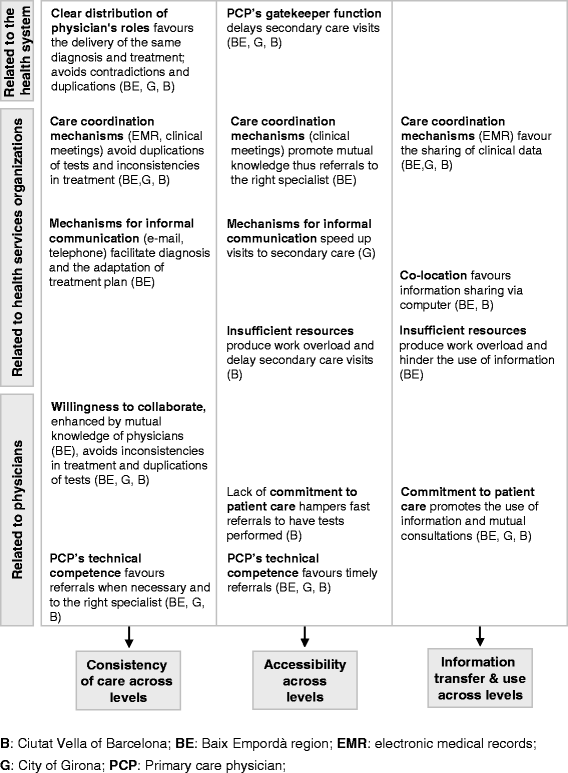Continuity of clinical management and information across care levels: perceptions of users of different healthcare areas in the Catalan national health system
- PMID: 27590595
- PMCID: PMC5010665
- DOI: 10.1186/s12913-016-1696-8
Continuity of clinical management and information across care levels: perceptions of users of different healthcare areas in the Catalan national health system
Abstract
Background: The integration of health care has become a priority in most health systems, as patients increasingly receive care from several professionals in various different settings and institutions, particularly those with chronic conditions and multi-morbidities. Continuity of care is defined as one patient experiencing care over time as connected and coherent with his or her health needs and personal circumstances. The objective is to analyse perceptions of continuity of clinical management and information across care levels and the factors influencing it, from the viewpoint of users of the Catalan national health system.
Methods: A descriptive-interpretative qualitative study was conducted using a phenomenological approach. A two-stage theoretical sample was selected: (i) the study contexts: healthcare areas in Catalonia with different services management models; (ii) users ≥ 18 years of age who were attended to at both care levels for the same health problem. Data were collected by means of individual semi-structured interviews with patients (n = 49). All interviews were recorded and transcribed. A thematic content analysis was conducted segmented by study area, with a mixed generation of categories and triangulation of analysts.
Results: Patients in all three areas generally perceived that continuity of clinical management across levels existed, on referring to consistent care (same diagnosis and treatment by doctors of both care levels, no incompatibilities of prescribed medications, referrals across levels when needed) and accessibility across levels (timeliness of appointments). In terms of continuity of information, patients in most areas mentioned the existence of information sharing via computer and its adequate usage. Only a few discontinuity elements were reported such as long waiting times for specific tests performed in secondary care or insufficient use of electronic medical records by locum doctors. Different factors influencing continuity were identified by patients, relating to the health system itself (clear distribution of roles between primary and secondary care), health services organizations (care coordination mechanisms, co-location, insufficient resources) and physicians (willingness to collaborate, commitment to patient care, the primary care physician's technical competence).
Conclusions: Care continuity across care levels is experienced by patients in the areas studied, with certain exceptions that highlight where there is room for improvement. Influencing factors offer valuable insights on where to direct coordination efforts.
Keywords: Continuity of patient care; Health information management; Patient care management; Patient navigation; Qualitative research; Quality of health care.
Figures
References
-
- Ovretveit J. Does improving quality save money? A review of evidence of which improvements to quality reduce costs to health service providers. London: The Health Foundation; 2009.
-
- McKee M, Nolte E. Chronic care. Cambridge: Cambridge University Press; 2009. Performance measurement for health system improvement: experiences, challenges and prospects; pp. 406–25.
-
- Reid RJ, Haggerty JL, McKendry R. Defusing the confusion: concepts and measures of continuity of healthcare. Ottawa: Canadian Health Services Research Foundation; 2002.
MeSH terms
LinkOut - more resources
Full Text Sources
Other Literature Sources


